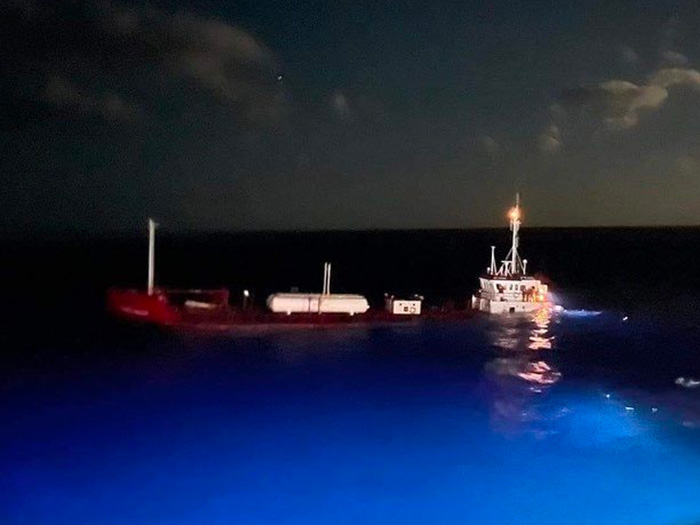
NTSB reports on collision that saw tanker sink after being struck by super yacht
Written by Nick Blenkey
@Superyachtfan tweeted this photo of Tropic Breeze before it finally sank
The National Transportation Safety Board (NTSB) has issued its report on the December 23, 2021, incident in which the 750 dwt Belize-flagged product tanker Tropic Breeze, was struck by the 2018-built super yacht Utopia IV and sank when en route to Norwegian Cruise Line Holding’s private island in the Bahamas, Great Stirrup Cay.
The tanker was operated by Miami-headquartered Miami Maritime Management. According to media reports at the time, the yacht was owned by billionaire and socialite JR Ridinger who, less than a year later, on August 30, 2022, was to die aboard the same vessel after suffering a pulmonary embolism while it was docked in Croatia.
The vessels were transiting the Northeast Providence Channel when the collision occurred. The Tropic Breeze’s engine room flooded, and the vessel eventually sank. The vessel’s seven crewmembers abandoned ship and were rescued by a Good Samaritan vessel. Three of the 12 crewmembers on the Utopia IV were injured.
FAILURE TO MAINTAIN A PROPER LOOKOUT
The NTSB determined that the probable cause of the collision was the Utopia IV’s wheelhouse crew not maintaining a proper lookout and therefore not identifying the tank vessel they were overtaking. Contributing was the Tropic Breeze’s bridge team also not maintaining a proper lookout.
Before the collision, the captain of the Utopia IV was conning the vessel while the bosun navigated and kept a bridge log. On the Tropic Breeze, the master and an able seafarer were on watch on the bridge.
The captain of the Utopia IV left the bridge shortly before the collision to check on the seven yacht passengers. The bosun, who was not credentialed as a watch officer and was not allowed by regulations to conn the vessel alone, was left performing watchstanding duties by himself and logging navigational data.
At 11:00 p.m. Eastern time, the bow of the Utopia IV, traveling at about 20 knots, struck the transom of the Tropic Breeze from directly astern.
None of the watchstanders on the Utopia IV or Tropic Breeze reported seeing the other vessel on radar. According to the report, it is likely none of the watchstanders had looked at the radar in the 12 minutes before the collision.
AIS INOPERATIVE
The report notes that the Tropic Breeze’s AIS was inoperative at the time of the incident due to a power issue. Investigators queried databases and found the unit had not transmitted a position in 11 months. (There were repair parts on board awaiting a technician.) Had the unit been functioning, it is likely that the Utopia IV could have detected the Tropic Breeze before the collision, notes the NTSB. Likewise, with the unit inoperative, the Tropic Breeze could not display the Utopia IV’s AIS signal and identify the yacht’s position relative to the tank vessel.
NTSB investigators concluded that if either vessel had kept a proper lookout, they likely would have detected each other and could have taken action to avoid the collision.
“A proper lookout by suitably trained crewmembers is required by the Convention on the International Regulations for Preventing Collisions at Sea, 1972 and is essential in determining the risk of collision,” the report said. “The effective use of all available resources by a bridge team, including visual scanning, radars, electronic charts, and an automatic identification system, increases collective situational awareness and contributes to a safe navigation watch. Operators and crews should ensure that vessel bridge teams are staffed with certificated/credentialed mariners who are familiar with all bridge navigation equipment and able to independently take immediate action.”
Download the full report HERE




